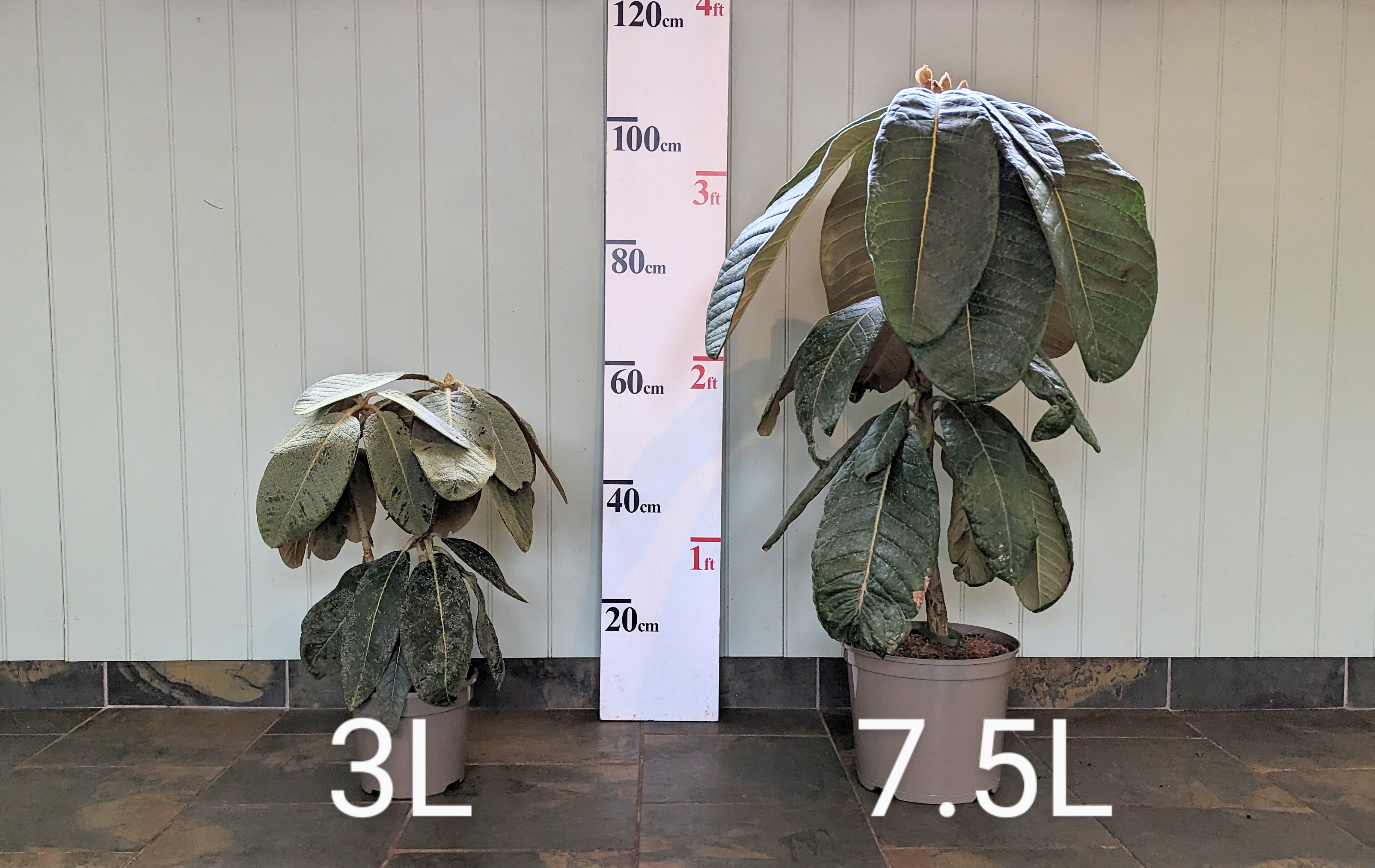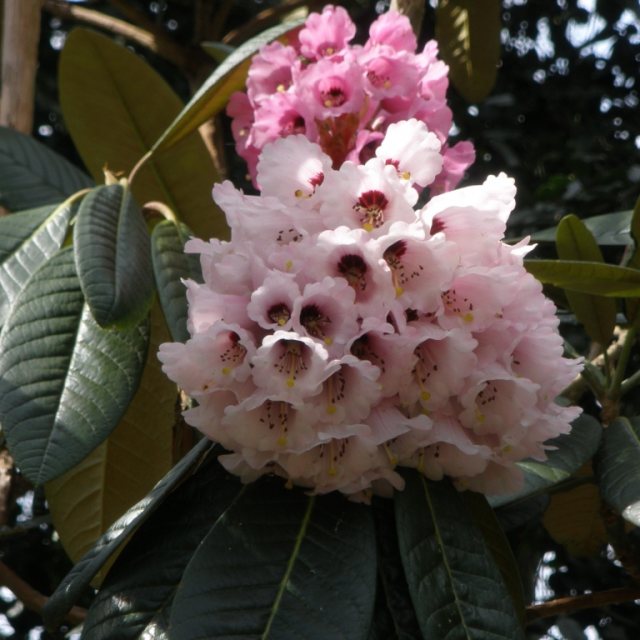Rhododendron hodgsonii
Item: SHODG
 Currently Unavailable
Currently Unavailable
April
Mid Pink
150-175cm
Not Scented
Yes
To -15 °C
Collect in Store
This item is available for collection.
Home Delivery
UK mainland delivery from £8.95
A spectacular shrub with large trusses of pinkish or purplish red flowers which tend to fade, flowering in April. This is one of the hardiest of the big leaved Rhododendrons with smooth peeling bark and large leathery leaves up to 38cm long with a thin indumentum giving a silvery/metallic bloom. The underside of the leaves have an attractive silvery to cinnamon indumentum and young growth is just stunning. Height 150cm in 10 years.
Big leaf Rhododendron species have great architectural foliage which looks stunning in a woodland glade or city courtyard garden. However, the lovely large leaves do need protection from winds, especially cold winds, to prevent them being marked or damaged. Strong winds can even snap off these big leaves at the petiole (leaf stalk) or midrib and ruin the plant. Carefully choose a sheltered, moist but well drained position, and you'll grow a fantastic foliage plant with the bonus of wonderful flowers after 6 to 10 years.
Named after B.H. Hodgson, the former East India Company Resident in Nepal. The painting is by Walter Hood Fitch, based Joseph Dalton Hooker's field sketch. It appears in Hooker's landmark book 'Rhododendrons of the Sikkim Himalaya', published in 1849.
- Recommended for wonderful foliage.
- Plantsman range.
- Ideal position: Sheltered woodland or shaded courtyards, avoiding cold winds.
- Habit: tree-like.
- Group: Species Rhododendron.
- Subsection: Falconera.
- Introduction date: pre 1900 (1850).
- Species distribution: Sikkim, Nepal, Bhutan, Assam, S Tibet.
- Approximate altitude: 2,900 to 4,300m.
- Ideal soil: pH 4.5 to 6.5.
- RHS Hardiness Rating: H6.
- How we usually propagate this plant: Seed.
Customer Reviews

Good to know
Wonderful architectural plants with huge leaves up to 60cm long! These are choice woodland Rhododendrons needing the very best sheltered positions to allow them to grow to their full stature of up to 5 metres. As a bonus, flowering will typically start after 6 years, but can take up to 10 years. Big leaved Rhododendrons are among the more tender of our range, but are well worth trying if you have the correct conditions. They are best suited to sheltered woodland in the milder regions of the UK, though they can also be used as feature plants in sheltered courtyard gardens. Winter protection is recommended for young plants.
Rhododendrons like moist acidic soil, with good drainage, and plenty of organic matter such as leaf-mould and added ericaceous compost. Big-leaved species should be given the best planting positions, which are neither too wet nor too dry. For a guide to plant spacing, use the height we give in 10 years as a guide to the distance between each plant, or approximately 1 plant per 3m². Plant no deeper than the top of the rootball, and dig in plenty of good ericaceous compost around the sides. A teaspoon of slow release feed is sufficient for a 3 litre plant, rising to a small handful for a mature plant. Plants can be grown as single stemmed trees, or the leader can be pruned as a young plant to encourage a more bushy habit. You may need to give protection from deer rubbing their antlers on the stems
Please note: Big leaved Rhododendrons need to be sheltered from wind to prevent the large leaves being broken off at the petioles (stalks) during gales. Moisture control is critical to prevent moisture stress and misshapen leaves, so we do not recommend them being grown in pots.
For further advice, For further advice, see here
Size Guide

The Basics
Ideal soil
Acidic soil, good organic content, pH 4.5-6.0. Inkarho range of rhododendrons will tolerate soils up to pH7.5
Sun or Shade
Light dappled shade is best for most varieties.
Shelter
Refer to hardiness rating. Give young plants protection.
Site Selection
Avoid close to trees, roots, invasive weeds, walls, hot patios, dry banks and waterlogged soils. Do not use weed matting or stone mulch.
Plant spacing
Use the height shown in 10 years as a guide to the distance between each plant. Allow room for plant to fill out. If planting closer for instant impact, be prepared to move plants after a few years.
Compost
- 3 litre pot, dig in 10-20 litres of ericaceous compost.
- 7.5 litre pot, dig in 20-30 litres of ericaceous compost.
- 70-80cm specimen, dig in 60 litres of ericaceous compost.
- 100-120cm specimen, dig in 120 litres of ericaceous compost.
Planting depth
Plant high in the ground, with the top of the rootball visible.
Feeding
Slow-release ericaceous feed recommended in March and straight after flowering.
Mulch
Recommended every few years.
Water
The key ingredient! Keep moist all season, especially the critical time at end of June for flower bud initiation. Tap water is better than no water. Heavy dose at least once per week in dry weather.
Drainage
Ensure good drainage in winter, especially with yellow flowering varieties. Avoid waterlogged sites.
Pruning
Rhododendrons and Camellias: Not normally required. Tidy wayward shoots after flowering.
Evergreen azaleas and Bloombux can be clipped into a low hedge.
Magnolias and Acers: Formative pruning when young to shape into a tree or bush.
Deadheading
Remove old flower-heads, particularly on young or weak plants.
For further advice see here
Delivery & Returns
Our website calculates the delivery charge according to weight and delivery location throughout the UK. To see these charges, please enter your postcode at the checkout, and you will see the charge vary as you add more items to your wheelbarrow.
 Millais Nurseries
Millais Nurseries



